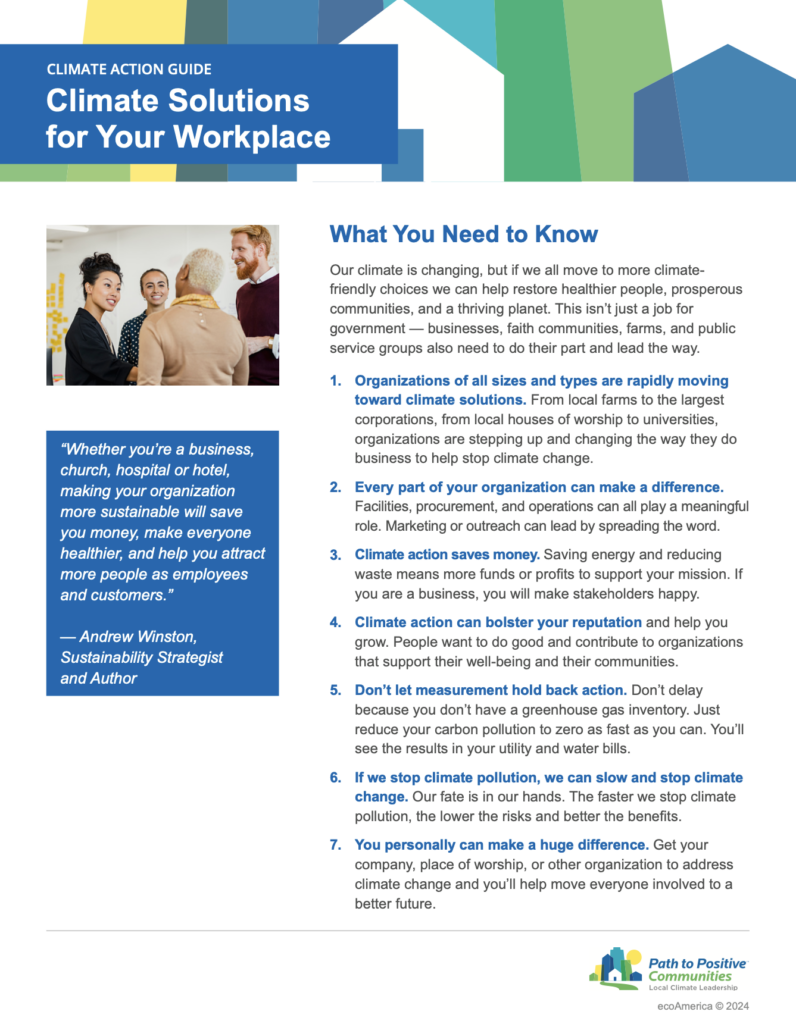
What You Need To Know
Our climate is changing, but if we all move to more climate-friendly choices we can help restore healthier people, prosperous communities, and a thriving planet. This isn’t just a job for government — businesses, faith communities, farms, and public service groups also need to do their part and lead the way.
- Organizations of all sizes and types are rapidly moving toward climate solutions. From local farms to the largest corporations, from local houses of worship to universities, organizations are stepping up and changing the way they do business to help stop climate change.
- Every part of your organization can make a difference. Facilities, procurement, and operations can all play a meaningful role. Marketing or outreach can lead by spreading the word.
- Climate action saves money. Saving energy and reducing waste means more funds or profits to support your mission. If you are a business, you will make stakeholders happy.
- Climate action can bolster your reputation and help you grow. People want to do good and contribute to organizations that support their well-being and their communities.
- Don’t let measurement hold back action. Don’t delay because you don’t have a greenhouse gas inventory. Just reduce your carbon pollution to zero as fast as you can. You’ll see the results in your utility and water bills.
- If we stop climate pollution, we can slow and stop climate change. Our fate is in our hands. The faster we stop climate pollution, the lower the risks and better the benefits.
- You personally can make a huge difference. Get your company, place of worship, or other organization to address climate change and you’ll help move everyone involved to a better future.
What You Need To Do
We can all make our workplace better. The most important thing to do is to get started. Pick one or two actions from the list below and do them now. The rest will follow more easily.
- Make sure climate and community well-being are part of your organization’s mission. A stated climate position makes your motives and actions clear to staff and stakeholders.
- Involve others. Invite staff, volunteers, and stakeholders into a discussion about what you should do and why. Schedule a lunch and find out how they can help. List their ideas, build commitment, and publish an action plan.
- Focus on the benefits. Staff and stakeholders will support your efforts if they know the outcomes. Emphasize the health, shared prosperity, and safety benefits of reducing pollution, and a safer, more secure future that comes with addressing climate change.
- Make 100% clean renewable energy your goal, with a target date. Half measures won’t inspire your organization and won’t solve the problem. You might be able to switch to clean energy at low cost almost immediately. Set interim goals with target dates too.
- Start with the easy, obvious successes. Change to LED lights, motion sensors and timers for lighting, shades near bright windows, recycling bins, and plants for fresh air.
- Move beyond your walls. How do people get to your facility? Encourage them to activate climate solutions in how they get to work and at home.
- Engage other organizations and the community. Share your plans and commitments publicly and volunteer to share your success with other organizations. You’ll build your reputation and improve your community.
Organizations have discovered that when they involve their staff and stakeholders in climate solutions it builds a sense of teamwork and purpose. Telling the broader community your story of climate purpose, action, and success will inspire others and build loyalty.

“Whether you’re a business, church, hospital or hotel, making your organization more sustainable will save you money, make everyone healthier, and help you attract more people as employees and customers.”
— Andrew Winston, Sustainability Strategist and Author

